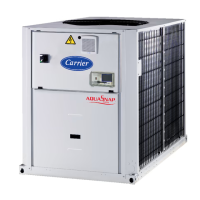50
This level requires specific know-how in the electrical,
hydronic and mechanical elds. It is possible that these skills
are available locally: existence of a maintenance service,
industrial site, specialised subcontractor.
The frequency of this maintenance level can be monthly or
annually depending on the verication type.
In these conditions, the following maintenance operations
are recommended.
Carry out all level 1 operations, then:
Electrical checks
• At least once a year tighten the power circuit electrical
connections (see table with tightening torques).
• Check and retighten all control/command connections, if
required (see table with tightening torques).
• Remove the dust and clean the interior of the control
boxes, if required.
• Check the status of the contactors, disconnect switches
and capacitors.
• Check the presence and the condition of the electrical
protection devices.
• Check the correct operation of all heaters.
• Check that no water has penetrated into the control box.
• For units equipped with a variable-speed drive regularly
check the cleanliness of the lter media to maintain the
correct air ow.
Mechanical checks
• Check the tightening of the fan tower, fan, compressor
and control box xing bolts.
Water circuit checks
• Always take care when working on the water circuit to
ensure that the condenser close by is not damaged.
• Check the water connections.
• Check the expansion tank for signs of excessive corro-
sion or gas pressure loss and replace it, if necessary.
• Purge the water circuit (see chapter ‘Water ow control
procedure’).
• Clean the water lter (see chapter ‘Water ow control
procedure’).
• Replace the pump ttings after 15000 hours of operation
with defrost solution or after 25000 hours of opera-tion
with water.
• Check the operation of the low water ow rate safety
device.
• Check the status of the thermal piping insulation.
• Check the concentration of the anti-freeze protection
solution (ethylene glycol or propylene glycol).
Refrigerant circuit
• Fully clean the air heat exchangers with a low-pressure
jet and a bio-degradable cleaner.
• Check the unit operating parameters and compare them
with previous values.
• Carry out an oil contamination test. Replace the oil, if
necessary.
• Check and if necessary re-tighten the Rotalock
connections in the oil balancing line to the specied
torque value.
• Check the operation of the high-pressure switches.
Replace them if there is a fault.
• Check the fouling of the lter drier. Replace it if necessary.
• Keep and maintain a maintenance sheet, attached to
each HVAC unit.
All these operations require strict observation of adequate
safety measures: individual protection garments, compliance
with all industry regulations, compliance with applicable
local regulations and using common sense.
The maintenance at this level requires specic skills/approval/
tools and know-how and only the manufacturer, his repre-
sentative or authorised agent are permitted to carry out these
operations. These maintenance operations concern for
example:
• A major component replacement (compressor,
evaporator),
• Any intervention on the refrigerant circuit (handling
refrigerant),
• Changing of parameters set at the factory (application
change),
• Removal or dismantling of the HVAC unit,
• Any intervention due to a missed established maintenance
operation,
• Any intervention covered by the warranty.
• One to two leak checks per year with a certied leak
detector and carried out by a qualied person.
To reduce waste, the refrigerant and the oil must be trans-
ferred in accordance with applicable regulations, using
methods that limit refrigerant leaks and pressure drops and
with materials that are suitable for the products.
Any detected leaks must be repaired immediately.
The compressor oil that is recovered during maintenance
contains refrigerant and must be treated accordingly.
Refrigerant under pressure must not be purged to the open
air.
If a refrigerant circuit is opened, plug all openings, if the
operation takes up to one day, or for longer periods charge
the circuit with nitrogen.
NOTE: Any deviation or non-observation of these
maintenance criteria will render the guarantee conditions
for the HVAC unit nul and void, and the manufacturer,
Carrier SCS, will no longer be held responsible.

